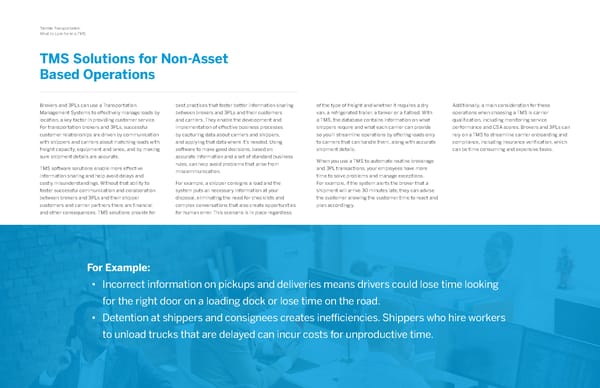7 Trimble Transportation What to Look for in a TMS TMS Solutions for Non-Asset Based Operations For Example: • Incorrect information on pickups and deliveries means drivers could lose time looking for the right door on a loading dock or lose time on the road. • Detention at shippers and consignees creates inefficiencies. Shippers who hire workers to unload trucks that are delayed can incur costs for unproductive time. Brokers and 3PLs can use a Transportation Management Systems to effectively manage loads by location, a key factor in providing customer service. For transportation brokers and 3PLs, successful customer relationships are driven by communication with shippers and carriers about matching loads with freight capacity, equipment and lanes, and by making sure shipment details are accurate. TMS software solutions enable more effective information sharing and help avoid delays and costly misunderstandings. Without that ability to foster successful communication and collaboration between brokers and 3PLs and their shipper customers and carrier partners there are financial and other consequences. TMS solutions provide for best practices that foster better information sharing between brokers and 3PLs and their customers and carriers. They enable the development and implementation of effective business processes by capturing data about carriers and shippers, and applying that data where it’s needed. Using software to make good decisions, based on accurate information and a set of standard business rules, can help avoid problems that arise from miscommunication. For example, a shipper consigns a load and the system puts all necessary information at your disposal, eliminating the need for checklists and complex conversations that also create opportunities for human error. This scenario is in place regardless of the type of freight and whether it requires a dry van, a refrigerated trailer, a tanker or a flatbed. With a TMS, the database contains information on what shippers require and what each carrier can provide so you’ll streamline operations by offering loads only to carriers that can handle them, along with accurate shipment details. When you use a TMS to automate routine brokerage and 3PL transactions, your employees have more time to solve problems and manage exceptions. For example, if the system alerts the broker that a shipment will arrive 30 minutes late, they can advise the customer allowing the customer time to react and plan accordingly. Additionally, a main consideration for these operations when choosing a TMS is carrier qualification, including monitoring service performance and CSA scores. Brokers and 3PLs can rely on a TMS to streamline carrier onboarding and compliance, including insurance verification, which can be time consuming and expensive tasks.
 What to Look for in a TMS Page 6 Page 8
What to Look for in a TMS Page 6 Page 8